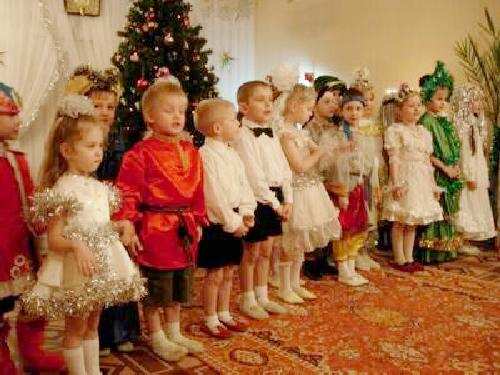
Figure 1.--Here we see a children's event celebrating Christmas in Russia, perhaps a Kindergarten group. We don't know when the photograph was taken, but think it was 2005. Public Christmas celevratiions were banned during the Soviet era. |


|
The Soviets of course discouraged the celebration of Christmas. Even without Christmas, Russian children eventually acquired Father Frost a replacement with ancient Slavic origins. Christmas traditions are reovering in post-Soviet Russia. St. Nicholas is now popular in Russia. The legend is that the 11th-century Prince Vladimir traveled to Constantinople to be baptized, and returned with stories of miracles performed by St. Nicholas of Myra. Since then many Eastern Orthodox Churches have been named for the saint, and to this day, Nicholas is one of the most common names for Russian boys. The feast of St. Nicholas (December 6) was observed for many centuries, but after the communist revolution, the celebration of the feast was suppressed. During the communist years St. Nicholas was transformed into Grandfather Frost. Other religious traditions were suppressed during the communist era. Before the revolution, a figure called Babouschka would bring gifts for the children. Like Italy's La Befana, the story is that Babouschka failed to give food and shelter to the three wise men during their journey to visit the Christ Child. According to tradition, she still roams the countryside searching for the Christ Child and visiting the homes of children during the Christmas season. Babouschka never completely disappeared, and now in the post-communist era, has returned openly. Christmas trees were also banned by the Communist regime, but people continued to trim their "New Year's" trees. Most Christian Russians belong to the Eastern Orthodox Church, and it is customary to fast until after the first church service on Christmas Eve. Christmas Eve dinner is meatless but festive. The most important ingredient is a special porridge called kutya. It is made of wheatberries or other grains which symbolize hope and immortality, and honey and poppy seeds which ensure happiness, success, and untroubled rest. A ceremony involving the blessing of the home is frequently observed. A priest visits the home accompanied by boys carrying vessels of holy water, and a little water is sprinkled in each room. The kutya is eaten from a common dish to symbolize unity.
Christmas is a religious holiday. The celebration of Christmas, however, were of course strongly affected by the political regime under which Russia was goverened. Russian Orthodox Christians during the Tsaeist era celebrated Christmas on January 7. Celebrations and fortune telling lasted for 12 days throught to Epiphany. This is the manifestation of Christ to the Gentiles, represented by the Magi. The Western view of Russian Christmas is strongly influenced by Peter Ilyich Tchikowsky's famed "The Nutcracker". Virtually every American child, especially the girls, has seen "The Nutcracker" ballet. This is, however, rather misleading. The Soviets of course discouraged the celebration of religious holidays such as Christmas. Christmas in fact was abolished. Many Christmas traditions were eventually transferred to New Years. Although the annual celebration of the Revolution for a toimebecame the holiday that children got their gifts. Many religious traditions were suppressed during the Communist era. Before the Revolution, even without Christmas, Russian children had Father Frost. Although Soviet officials first question the revolutionary credentials of Grandfather Frost, they eventually embraced him whole heartedly. We are not sure how Christmas traditions are faring in post-Soviet Russia. One journalist reports that she saw many features of Christmas in Moscow during 2002 such as twinling lights, Christmas songs, toy soldiers, and Christmas tree ornaments in markets. She notes, howeber, that Moscow authorities have mandated that ship keepers should have Christmas lights. Moscow's mayor Yuri Luzhkov has mandated this. Many in the provinces still observe the Orthodox Christmas. This is not yet the general pattern in cities like Moscow. Russians despite the encouragement to celebrate Christmas seem to prefer New Years.
There are several characters that figure in the Russian celebration of Christmas. Here we have to add in New Year which has acquired many Chrismast traditions.
St. Nicholas is popular in Russia. The legend is that the 11th-century Prince Vladimir traveled to Constantinople to be baptized, and returned with stories of miracles performed by St. Nicholas of Myra. Since then many Eastern Orthodox Churches have been named for the saint, and to this day, Nicholas is one of the most common names for Russian boys.
St. Nicholas as a gift bringer was more of a Western tradition and not one that that the conservative Russian Orthodox Church promoted. The Orthodoxial Church in Tsarist Russia was extremely conservative and in 1916 even tried to forbid a civil
celebration of Christmas (as German custom, imported by Peter the Great). The Church accepted only a clerical approach to Christmas. The feast of St. Nicholas (December 6) was observed for many centuries, but after the Communist Revolution, the celebration of the feast was suppressed. He has made something of a comeback since the disolution of the Soviet Union.
A figure called Babouschka in Tsarist Russia would bring gifts for the children. Like Italy's La Befana, the story is that Babouschka failed to give food and shelter to the three wise men during their journey to visit the Christ Child. According to tradition, she still roams the countryside searching for the Christ Child and visiting the homes of children during the Christmas season. Babouschka never completely disappeared, and now in the post-communist era, has returned openly. A Russian reader writes, "That is nomsence. Ann Appelbaum sometimes writes really wild things. There's not any "Babushka" for New Year or Christmas celebrations in Russia. I've noted several articles in the Russian presse mocking this nonsense along with other cold war-time myths like 'bears that walk on Russian streets' etc."
During the Communist years St. Nicholas was replaced with Grandfather Frost, a figure from ancient Slavic folk tales. The Soviets did not quickly adopt F=Grndfather Frost. Therewas considerable discussion of his Revolutionary credetials. The decision was finaly made in the 1930s, primarily on the basis that the children needed their presents. As the tradituon developed, it was common for Grandfather Frost to have an attractive snow maiden as an assistant--a decided improvement on American elves. It was part of an overall effort to move the religious Celbration to the secular celebration of New Year. We note that in some Soviet successor states (like Tajikistan) that Grandfather Frost is now being rferred to as Santa Claus. In modern Russia, the children are big winners. They have not only kept Grandfather Frost, but St. Nicholas is growing in importance. Thus they now have two gift givers.
There was a German influence in Russia, but we re not sure just how common Christmas Trees were before the Revolution. Christmas trees were also banned by the Communist regime, but people continued to trim their trees which became "New Year's" trees. The Chrismas star on the top of the fir-tree was considered as the red star of the Bolsheviks. In the West the Christmas star was always white or yellow. Apparentlt the Russian Christmas tree star was red. I'm not sure if this tradition continues.
Most Christian Russians belong to the Eastern Orthodox Church, and it is customary to fast until after the first church service on Christmas Eve. One source says that Christmas Eve dinner is meatless but festive. The most important ingredient is a special porridge called kutya. It is made of wheatberries or other grains which symbolize hope and immortality, and honey and poppy seeds which ensure happiness, success, and untroubled rest.
A Russian reader tells us that this is absolutely incorrect. "Meat (traditionally - fried piglet of st. Basil, "Kesariyskij Porosyenok", this tradition has a pagan roots) is always served as a Christmas feast. Fast, when it's forbidden to eat anything, longs before first star emerges on the sky, then all family can sit at the table."
A ceremony involving the blessing of the home is frequently observed. A priest visits the home accompanied by boys carrying vessels of holy water, and a little water is sprinkled in each room. The kutya is eaten from a common dish to symbolize unity. Our Russian reader writes, "Another wrong fact. Kutya (or "Kolivo" in South Russian and Ukrainian) is a ritual FUNERAL meal, this tradition is very ancient as well. To imagine this food on the holidays, especially New Year or Christmas table, is totally impossible."
Applebaum, Anne. "Santa's Russia" Washington Post (December 25, 2002), p. 29.
Navigate the Boys' Historical Clothing Web holiday pages:
[Return to the Main national Chrisrtmas page]
[Return to the Main Christmas page]
[New Years]
[Valetines]
[St. Patrick's Day]
[Easter]
[Fourth of July]
[Haloween]
[Thanksgiving]
Navigate the Boys' Historical Clothing Web Site:
[About Us]
[Introduction]
[Activities]
[Biographies]
[Chronology]
[Cloth and textiles]
[Garments]
[Countries]
[Topics]
[Bibliographies]
[Contributions]
[FAQs]
[Glossaries]
[Images]
[Links]
[Registration]
[Search]
[Tools]
[Boys' Clothing Home]
